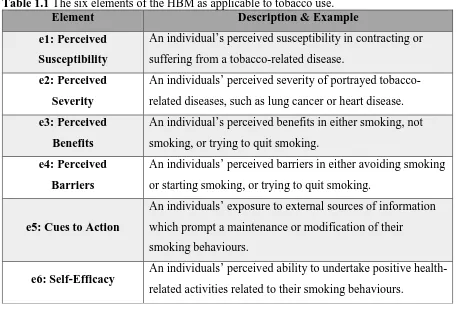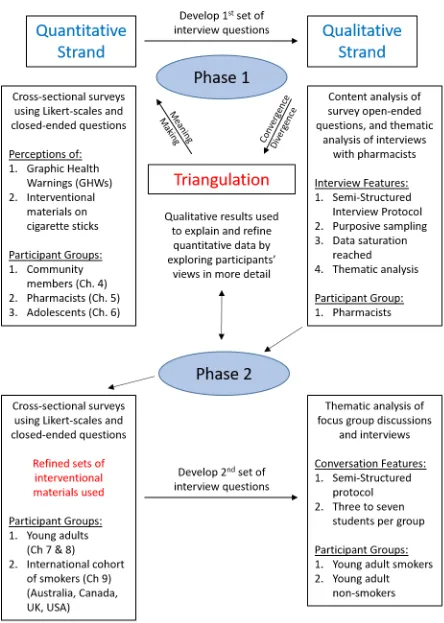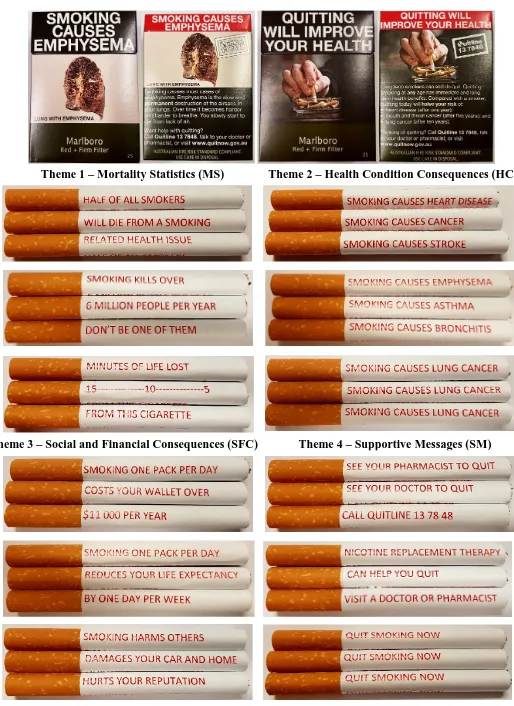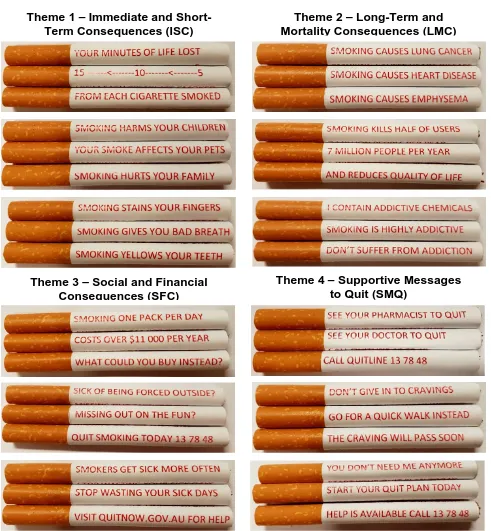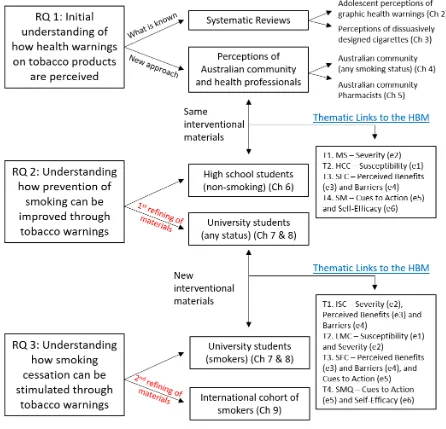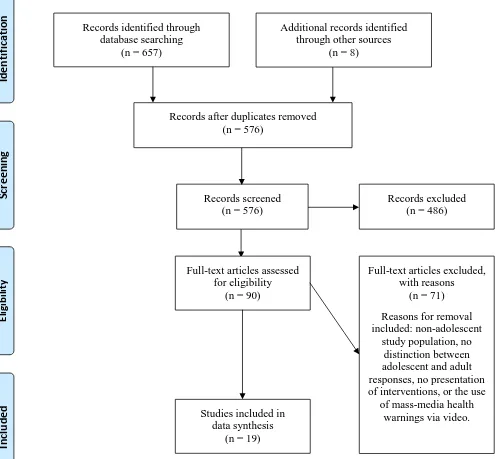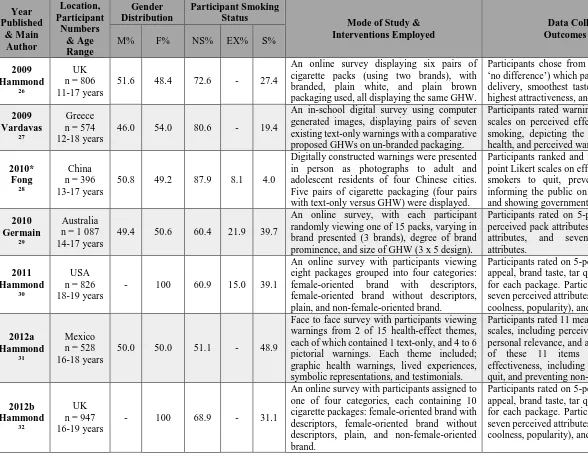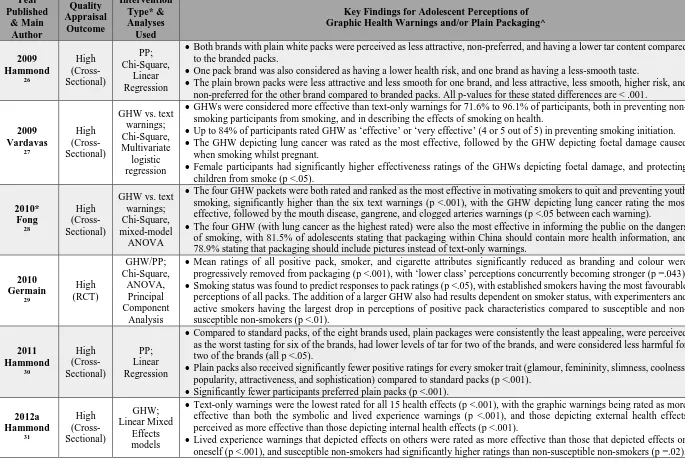ResearchOnline@JCU
This file is part of the following work:
Drovandi, Aaron (2018) Perceived effectiveness of tobacco packaging and
cigarette stick warnings as anti-tobacco interventions. PhD Thesis, James Cook
University.
Access to this file is available from:
https://doi.org/10.25903/5d23d483771df
Copyright © 2018 Aaron Drovandi.
The author has certified to JCU that they have made a reasonable effort to gain
permission and acknowledge the owners of any third party copyright material
included in this document. If you believe that this is not the case, please email
i
Perceived effectiveness of tobacco packaging
and cigarette stick warnings as anti-tobacco
interventions
Aaron Drovandi
BPharm – James Cook University, Australia
MPharmPH – James Cook University, Australia
This thesis is submitted for the degree of
Doctor of Philosophy
at
Discipline of Pharmacy, College of Medicine and Dentistry
Division of Tropical Health and Medicine
James Cook University
i
Statement of Access
I, Aaron Drovandi, the author of this thesis, understand that this thesis will be made available
for use to others. All users consulting this thesis will have to sign the following statement:
In consulting this thesis I agree not to copy or closely paraphrase it in whole or part without
the written consent of the author; and to make proper public written acknowledgement for any
assistance which I have obtained from it.
Beyond this, I do not wish to place any restriction on access to this thesis.
……….
(Author’s signature) (Date)
ii
Declarations
I declare that this thesis is my own work and has not been submitted in any form for another
degree or diploma at any university or institution of tertiary education. Information derived
from the published or unpublished work of others has been acknowledged in the text, and a list
of references is given.
I declare that the research included in this thesis was ethically conducted, with approval
received for each component of the research from the James Cook University Human Research
Ethics Committee. The following ethics approval codes relate to the research relevant to this
thesis: H6929, H7116, H7194.
……….
(Author’s signature) (Date)
iii
Acknowledgements
I would first like to extend my gratitude towards my primary advisor, Associate Professor
Bunmi Malau-Aduli, without whom this thesis would not have been possible. Her experience,
guidance, and patience greatly contributed towards all aspects of the thesis, and my mental
stability, for which I will be eternally grateful.
I would also like to thank my secondary advisor Associate Professor Peta-Ann Teague, and
advisor mentor (and close colleague) Professor Beverley Glass. Peta-Ann contributed greatly
to the planning of the original research proposal, and I appreciate her ongoing support
throughout this degree. Beverley has been the driving force behind most of my academic career
and has been instrumental in my ongoing teaching and research activities, and I could not be
more thankful for her support.
I am also grateful to Emeritus Professor Rhondda Jones for her enthusiasm and assistance in
the data analysis components of this thesis. I would also like to thank several of my colleagues
in the pharmacy school at JCU, including Dr Sheryl Robertson for her ability to laugh at the
most ridiculous of jokes, and for her assistance in the laboratory component of my earlier
research, and both Associate Professor Michelle Bellingan, and Associate Professor Ian Heslop
for their encouragement and leadership. Both Martina Mylrea and Tori Llewelyn I would like
to thank for their availability to bounce ideas off of, and mutual thesis complaining, and for the
provision of a friendly rivalry for publications and thesis completion.
I am also grateful to my parents Kevin and Debbie, and my brother Daniel for their ongoing
support throughout my three degrees, and serving as a welcoming destination for much needed
retreats from Townsville. Finally, I would like to thank all my friends and the staff at the Hot
Rock Adventure Centre in Townsville, who have provided me with a much-needed source of
iv
Contribution of Others
I would like to thank the following persons and organisations for their support in the following
roles, leading to the completion of this thesis.
Supervision
A/Prof Bunmi Malau-Aduli
A/Prof Peta-Ann Teague
Prof Beverley Glass
Financial Support
James Cook University Postgraduate Research Scholarship
James Cook University College of Medicine and Dentistry
Statistical and Analytical Support
A/Prof Bunmi Malau-Aduli
Emeritus Prof Rhondda Jones
Dr Sherryl Robertson
Editorial Support
A/Prof Bunmi Malau-Aduli
A/Prof Peta-Ann Teague
Prof Beverley Glass
Research Assistance
A/Prof Bunmi Malau-Aduli
Ms Robin Warren
v
Abstract
Introduction: Tobacco use remains the largest preventable cause of mortality in Australia,
despite significant reductions in the prevalence of daily smoking over the past 25 years.
Multiple public health interventions have contributed to these reductions, including health
warnings and graphic images on cigarette packaging. Whilst initially effective in curbing
tobacco use, recent research has identified that these packaging health warnings have become
less effective as an anti-tobacco intervention. As tobacco is still the cause of death of an
estimated 15 000 Australians per year, further improvements in anti-tobacco interventions are
needed. A novel anti-tobacco medium being investigated is the cigarette stick itself. As the
primary packaging of tobacco leaf used whilst smoking, it represents a logical and appropriate
medium for communicating the consequences of smoking. This research first aimed to confirm
recent findings suggesting that current cigarette packaging warnings have lost their
effectiveness. It also evaluated the perceptions of a diverse participant cohort towards the use
of cigarette sticks as a novel anti-tobacco intervention medium, and to inform on the
development of warnings and messages effective both in preventing non-smokers from
experimenting with cigarettes, and prompting current smokers to quit smoking.
Methods: A mixed methods approach was utilised, incorporating the use of online surveys,
and semi-structured focus groups and interviews. Established health warnings on current
cigarette packaging, and novel warnings and messages on individual cigarette sticks were
presented to a range of participants, including adolescents and young adults, pharmacists, an
international cohort of current smokers, and the wider Australian community. The Health
Belief Model (HBM) was utilised in developing the interventional materials. These materials
aimed to increase readers’ perceived susceptibility and severity of the negative consequences
of tobacco use, whilst also outlining the benefits of not smoking, and acting as an additional
vi focus group findings were triangulated and used to refine the health warnings and messages
used in subsequent surveys, focus groups and interviews. Quantitative data on participants’
perceived effectiveness of cigarette packaging and cigarette stick warnings were collected
using 5-point Likert scales, and analysed using Chi squared and proportional odds logistic
regression analyses. In-depth qualitative information was gathered to support and expand upon
the quantitative data, achieved through free-text comments in the surveys, and from focus
groups and interviews, which were analysed using content and thematic analyses respectively.
Results and Discussion: A total of 2 045 participants were involved in the research, of which
75% were Australian, 60% were female, 37% were smokers, and 80% were of Caucasian
descent. These participants were split amongst five primary populations: the wider Australian
community (637), pharmacists (79), school students (150), university students (501), and an
international cohort of smokers (678). Perceptions of the effectiveness of current cigarette
packaging warnings were generally consistent amongst all participant groups. These warnings
were considered minimally effective in prompting current smokers to quit, though slightly
more effective in preventing non-smokers from experimenting with cigarettes. Analyses of the
qualitative data identified several reasons for these poor ratings, including a loss of shock value
due to repetitive exposure over several years, simply ignoring the packaging warnings, and a
feeling that the warnings were irrelevant, particularly amongst the younger participants.
In comparison, several of the novel warnings and messages on individual cigarette sticks were
rated as significantly more effective than current packaging warnings in preventing
non-smokers from smoking, and prompting current non-smokers to quit. These warnings were
considered particularly effective in increasing participants’ perceived susceptibility and
severity to a wider range of consequences of smoking, and outlining the benefits of not
smoking. The financial costs of smoking was a message considered novel, engaging, and
vii particularly by current smokers (Odds Ratio [OR] = 3.42, 95% Confidence Interval [CI]
2.75-4.25, p<.001). This was supported by the open-text comments, with participants indicating that
financial stability is valued over avoiding potential health issues. Other warnings perceived as
effective throughout this research in comparison to current packaging warnings include the
‘minutes of life lost’ per cigarette (OR = 3.60, 95% CI 2.79-4.64, p<.001 amongst university
students), and the negative effects of smoking on family members (OR = 2.85, 95% CI
2.29-3.55, p<.001 amongst current smokers). These warnings were considered novel, relatable, and
engaging, making them capable of eliciting strong emotional responses likely to motivate
changes in smoking behaviour amongst smokers, and prevent experimentation amongst
non-smokers. Participants were also in favour of the inclusion of warnings and messages on
cigarette sticks, with over half (54%) of smokers and over three-quarters (87%) of non-smokers
either ‘agreeing’ or ‘strongly agreeing’. They believed that this anti-tobacco intervention would
be more difficult to avoid, and would reduce the aesthetic appeal of smoking, particularly
amongst adolescents.
Conclusions: This research has confirmed shortcomings in the effectiveness of current
cigarette packaging warnings, emphasising the need for improvements in anti-tobacco
interventions. The inclusion of novel and engaging warnings and messages on individual
cigarette sticks was found to be a potentially effective next step in combating the global tobacco
epidemic. It is essential that these warnings are able to elicit strong reactions by persons of any
age and smoking status. The vast majority of non-smokers, and over half of smokers were in
support of this novel anti-tobacco intervention. Future warning and message development for
both cigarette packaging and cigarette sticks should therefore include short-term health, and
non-health related consequences of tobacco use, since in this research they were found to be
viii
List of Publications
Published Thesis Chapters
Acknowledgement of changes: Some of these chapters have undergone minor changes in this
thesis manuscript in accordance with the recommendations made by the external examiners
that are not reflected in the published versions of this thesis. These changes do not affect the
results and overall findings of these chapters.
1. Drovandi A, Teague PA, Glass B, Malau-Aduli B. A systematic review of the
perceptions of adolescents on graphic health warnings and plain packaging of
cigarettes. Systematic Reviews. 2019;8:25 https://doi.org/10.1186/s13643-018-0933-0
(Chapter 2)
2. Drovandi A, Teague PA, Glass BG, Malau-Aduli B. A systematic review of smoker
and non-smoker perceptions of visually unappealing cigarette sticks. Tobacco Induced
Diseases. 2018;16(January):2. https://doi.org/10.18332/tid/82191 (Chapter 3)
3. Drovandi A, Teague PA, Glass B, Malau-Aduli B. Australian perceptions of health
messages and warnings on cigarette sticks. Submitted to International Journal of Public
Health. (Chapter 4)
4. Drovandi A, Teague PA, Glass B, Malau-Aduli B. Australian community pharmacist
experiences with smoking cessation and opinions of health warnings on individual
cigarette sticks. International Journal of Pharmacy Practice. 2019;27(2):121-130.
https://doi.org/10.1111/ijpp.12470 (Chapter 5)
5. Drovandi A, Teague PA, Glass B, Malau-Aduli B. Effectiveness of health warnings on
cigarette sticks: perceptions of school students in Queensland, Australia. Frontiers in
ix
6. Drovandi A, Teague PA, Glass B, Malau-Aduli B. Australian university student
perceptions of health messages on cigarette sticks. Health Communication. Published
online 24th January 2019. https://doi.org/10.1080/10410236.2019.1567442. (Chapter 7)
7. Drovandi A, Teague PA, Glass B, Malau-Aduli B. Do health warnings on cigarette
sticks affect perceptions towards smoking? A focus group study of Australian
university students. Accepted in Psychology Research and Behaviour Management. [In
Press]. (Chapter 8)
8. Drovandi A, Teague PA, Glass B, Malau-Aduli B. A four-country study on smoker
perceptions of health warnings on cigarette sticks. Accepted in Tobacco Induced
Diseases. [In Press]. (Chapter 9)
Conference Presentations
1. Drovandi AD, Teague PA, Glass BD, Malau-Aduli BS. Health Warnings on Cigarette
Sticks: The Next Step in Reducing Tobacco Use? Oral presentation at the James Cook
University Research Festival, September, 2017, Townsville, QLD, Australia
2. Drovandi AD, Teague PA, Glass BD, Malau-Aduli BS. Perceptions of Visual
Cigarette Stick Attributes: A Systematic Review. Oral presentation at the Townsville
x
Table of Contents
Statement of Access ... i
Declarations ... ii
Acknowledgements ... iii
Contribution of Others ... iv
Abstract ... v
List of Publications ... viii
Table of Contents ... x
List of Tables ... xix
List of Figures ... xxi
List of Abbreviations ... xxiii
Chapter ONE: General Introduction ... 1
1.1 THE TOBACCO EPIDEMIC ... 1
1.2 ANTI-TOBACCO PACKAGING INTERVENTIONS ... 1
1.2.1 Shortcomings of Packaging Interventions ... 3
1.2.2 Cigarette Sticks as an Anti-Tobacco Medium ... 4
1.3 THESIS AIMS AND HYPOTHESES ... 5
1.3.1 Aims ... 5
1.3.2 Hypotheses ... 5
1.3.3 Research Questions ... 6
xi
1.4.1 The Health Belief Model ... 6
1.5 METHODOLOGY ... 8
1.5.1 Research Design... 8
1.5.2 Key Participant Groups ... 10
1.5.3 Design of Interventional Materials ... 11
1.5.4 Analytical Techniques Utilised ... 16
1.5.5 Interpretation of Results ... 18
1.6 CONCEPTUAL FRAMEWORK ... 19
1.6.1 Thesis Outline ... 19
1.7 CHAPTER SUMMARY ... 22
1.8 REFERENCES ... 26
Chapter TWO: A Systematic Review of the Perceptions of Adolescents on Graphic Health Warnings and Plain Packaging of Cigarettes ... 30
2.1 ABSTRACT ... 31
2.2 BACKGROUND ... 32
2.3 METHODS ... 34
2.3.1 Eligibility Criteria ... 34
2.3.2 Search Strategy and Study Selection ... 35
2.3.3 Data Extraction and Quality Appraisal ... 35
2.3.4 Data Analysis ... 36
2.4 RESULTS ... 36
xii
2.4.2 Quality Appraisal ... 38
2.4.3 Graphic Health Warnings ... 45
2.4.4 Plain Packaging ... 47
2.4.5 Combination of Graphic Health Warnings and Plain Packaging ... 49
2.5 DISCUSSION ... 49
2.5.1 Strengths and Limitations ... 54
2.6 CONCLUSION ... 55
2.7 REFERENCES ... 56
Appendix 2.1 – PRISMA Checklist for the Systematic Review in Chapter 2 ... 60
Appendix 2.2 – Search Strategy for the Systematic Review in Chapter 2 ... 63
Chapter THREE: A Systematic Review of Smoker and Non-Smoker Perceptions of Visually Unappealing Cigarette Sticks ... 64
3.1 ABSTRACT ... 65
3.2 INTRODUCTION ... 66
3.3 METHODS ... 67
3.3.1 Study Selection ... 67
3.3.2 Data Sources ... 67
3.3.3 Synthesis of Results ... 68
3.3.4 Quality Appraisal ... 68
3.4 RESULTS ... 69
3.4.1 Study Characteristics ... 69
xiii
3.4.3 Perceptions of Physical Cigarette Design ... 73
3.4.4 Perceptions of Health Messages on Cigarettes ... 76
3.5 DISCUSSION ... 77
3.6 CONCLUSION ... 82
3.7 REFERENCES ... 82
Chapter FOUR: Australian Perceptions of Health Warnings on Cigarette Packaging and Cigarette Sticks ... 86
4.1 ABSTRACT ... 87
4.2 INTRODUCTION ... 89
4.3 METHODS ... 90
4.3.1 Study Design ... 90
4.3.2 Procedure and Data Items Collected ... 91
4.3.3 Analysis... 94
4.4 RESULTS ... 94
4.4.1 Demographic Profile ... 94
4.4.2 Ratings of Perceived Warning Effectiveness ... 95
4.4.3 Comments on Perceived Warning Effectiveness ... 98
4.4.4 Opinions of Health Warnings on Tobacco Products... 100
4.5 DISCUSSION ... 101
4.6 CONCLUSION ... 103
xiv Chapter FIVE: Australian Community Pharmacist Experiences with Smoking Cessation and
Perceptions of Health Warnings on Individual Cigarette Sticks ... 107
5.1 ABSTRACT ... 108
5.2 INTRODUCTION ... 109
5.3 METHODS ... 110
5.3.1 Study Design ... 110
5.3.2 Procedure and Data Items Collected ... 111
5.3.3 Analysis... 114
5.4 RESULTS ... 115
5.4.1 Participant Demographics ... 115
5.4.2 Ratings of Current Packaging and Cigarette Stick Warnings ... 116
5.4.3 Perceptions of Effective and Ineffective Health Warnings ... 117
5.5 DISCUSSION ... 120
5.6 CONCLUSION ... 123
5.7 REFERENCES ... 124
Appendix 5.1 – The interview questionnaire utilised with pharmacists in Chapter 5 ... 127
Chapter SIX: Effectiveness of Health Warnings on Cigarette Sticks: Perceptions of School Students in Queensland, Australia ... 128
6.1 ABSTRACT ... 129
6.2 INTRODUCTION ... 131
6.3 METHODS ... 133
xv
6.3.2 Procedure and Data Items Collected ... 133
6.3.3 Analysis... 135
6.4 RESULTS ... 137
6.4.1 Demographic Profile ... 137
6.4.2 Health Warning Effectiveness: Cigarette Packaging ... 138
6.4.3 Health Warning Effectiveness: Cigarette Sticks ... 139
6.4.4 Opinions of Health Warnings on Tobacco Products... 141
6.5 DISCUSSION ... 142
6.6 CONCLUSION ... 145
6.7 REFERENCES ... 146
Chapter SEVEN: Australian University Student Perceptions of Health Messages on Cigarette Sticks ... 149
7.1 ABSTRACT ... 150
7.2 INTRODUCTION ... 151
7.3 METHODS ... 153
7.3.1 Study design and recruitment... 153
7.3.2 Procedure and data items ... 153
7.3.3 Analysis... 155
7.4 RESULTS ... 157
7.4.1 Demographic profile ... 157
7.4.2 Ratings of packaging and cigarette-stick warning effectiveness ... 157
xvi
7.5 DISCUSSION ... 164
7.6 CONCLUSION ... 168
7.7 REFERENCES ... 169
Chapter EIGHT: Do Health Warnings on Cigarette Sticks Dissuade Smokers and Non-Smokers? A Focus Group Study of Australian University Students ... 173
8.1 ABSTRACT ... 174
8.2 INTRODUCTION ... 175
8.3 METHODS ... 177
8.4 RESULTS ... 181
8.4.1 RQ1: Perceptions of current cigarette packaging warnings ... 181
8.4.2 RQ2: Perceptions of Cigarette Stick Warnings and Messages ... 185
8.4.3 RQ3: Future forms of anti-tobacco interventions ... 188
8.5 DISCUSSION ... 190
8.6 CONCLUSION ... 193
8.7 REFERENCES ... 194
Chapter NINE: Smoker Perceptions of Health Warnings on Cigarette Sticks: A Four-Country Study ... 198
9.1 ABSTRACT ... 199
9.2 INTRODUCTION ... 201
9.3 METHODS ... 202
9.3.1 Study Design and Participant Recruitment ... 202
xvii
9.3.3 Analysis... 204
9.4 RESULTS ... 206
9.4.1 Demographic Profile ... 206
9.4.2 Perceived Effectiveness of Current Cigarette Packaging Warnings ... 207
9.4.3 Perceived Effectiveness of Health Warnings on Cigarette Sticks ... 209
9.4.4 Support for Health Warnings on Cigarette Sticks... 211
9.5 DISCUSSION ... 212
9.6 CONCLUSION ... 216
9.7 REFERENCES ... 217
Appendix 9.1 – Country-specific Likert scale ratings of cigarette packaging and cigarette stick health warnings... 220
Chapter TEN: General Discussion ... 221
10.1 DISCUSSION ... 221
10.1.1 Initial Understanding of Perceptions of Packaging Warnings ... 225
10.1.2 Understanding of Smoking Prevention and Cessation with Cigarette-Stick Warnings ... 227
10.1.3 Support for Cigarette Stick Warnings as a Public Health Intervention ... 231
10.1.4 Summary of Findings ... 233
10.1.5 Implications of Findings ... 234
10.1.6 Strengths and Limitations of the Research ... 237
10.1.7 Reflections on Research ... 239
xviii
Chapter ELEVEN: Conclusions & Recommendations... 244
11.1 CONCLUSIONS... 244
11.1.1 Updating of Cigarette Packaging Warnings ... 244
11.1.2 Implementation of Cigarette Stick Warnings ... 245
11.2 RECOMMENDATIONS ... 246
11.2.1 Policymakers ... 246
11.2.2 Researchers ... 247
11.2.3 Health Professionals... 248
APPENDICES ... 249
Appendix A – Report to Key Stakeholders... 249
xix
List of Tables
Table 1.1 The six elements of the HBM as applicable to tobacco use. ………….………..8
Table 1.2 Thesis Outline, Chapter Details, and Submission Status of Publication Chapters. 23
Table 2.1 Participant and methodological characteristics of articles eligible for inclusion in this
systematic review (n = 19). ………..39
Table 2.2 Quality appraisal outcomes and study outcomes for each of the eligible studies (n =
19). ………...42
Table 3.1 Study characteristics and participant demographics for eligible articles. ………….71
Table 3.2 Summary of interventions, participant tasks, and analytical methods utilized within
each included study. ……….72
Table 4.1 Demographic characteristics and baseline perceptions of survey participants. ……95
Table 4.2 Proportional odds logistic regression model, with odds ratios for themes of cigarette
stick warnings. ……….96
Table 5.1 Demographic characteristics of pharmacists participating in the online survey (n =
70). ……….115
Table 5.2 Mean ranks of interventions compared to current packaging warnings. ………….116
Table 5.3 Proportional odds logistic regression model, with odds ratios for themes. ……….117
Table 6.1 Demographic characteristics and baseline perceptions of survey participants. …..137
Table 6.2 Mean ranks of interventions compared to current packaging warnings. ………….138
Table 6.3 Proportional odds logistic regression model, with odds ratios for themes of cigarette
xx Table 7.1 Demographic characteristics and baseline perceptions of participating students. ..158
Table 7.2 Mean ranks of interventions compared to current packaging warnings. ………….158
Table 7.3 Proportional odds logistic regression model. ……….160
Table 8.1 Participant characteristics for focus groups and phone interviews. ………182
Table 9.1 Participant demographics for each country (total n = 687). ………208
Table 9.2 Proportional odds logistic regression model, with bolded p-values showing points of
significance within the data. ………...210
Table 10.1 Primary findings of each chapter and their contributions to the thesis, including the
xxi
List of Figures
Figure 1.1 Four examples of the front and rear of current cigarette packaging in Australia,
including text-warnings, graphic images, and standardised (plain) packaging. ………..2
Figure 1.2 Illustration of the mixed-methods sequential explanatory design utilised in this
thesis. ………...13
Figure 1.3 The initial set of cigarette stick warnings developed in this thesis. ……….15
Figure 1.4 The refined cigarette-stick warnings and themes utilised in Chapters 7 and 8. …...17
Figure 1.5 The final cigarette-stick warnings and messages used in Chapter 9. ………...18
Figure 1.6 Illustration of the conceptual framework of the thesis. ………..21
Figure 2.1 Flow chart of systematic literature search. ………..37
Figure 3.1 Flow chart of systematic literature search. ………..70
Figure 4.1 The front and back of two cigarette packaging in circulation in Australia, and the
twelve cigarette warnings divided in to the four themes. Each cigarette includes three lines of
text and is rotated to read the entire message. ………...92
Figure 5.1 The front and back of two cigarette packaging in circulation in Australia, and the
twelve cigarette warnings divided in to the four themes. Each cigarette includes three lines of
text and is rotated to read the entire message. ……….113
Figure 6.1 The front and back of two cigarette packaging in circulation in Australia, and the
twelve cigarette warnings divided in to the four themes. Each cigarette includes three lines of
xxii Figure 7.1 The front and back of two cigarette packaging in circulation in Australia, and the
twelve cigarette warnings divided in to the four themes. Each cigarette includes three lines of
text and is rotated to read the entire message. ……….156
Figure 8.1 The front and back of two cigarette packaging in circulation in Australia, and the
twelve cigarette warnings divided in to the four themes. Each cigarette includes three lines of
text and is rotated to read the entire message. ……….180
Figure 8.2 Elements (e1-6) of the Health Belief Model influenced by health warnings on
current cigarette packaging, and individual cigarette sticks in this study, and perceived
outcomes. ………...184
Figure 9.1 Cigarette packaging warnings displayed to participants from each country;
Australia (top), Canada (second), United Kingdom (third), United States (bottom). ………205
Figure 9.2 Eight cigarette-stick warnings and messages displayed to participants (in random
order). Note: Cigarettes 5 and 8 were different in each of the four versions of the survey to
account for country-specific differences in the financial cost of smoking (Australia: $11 000,
xxiii
List of Abbreviations
AD: Aaron Drovandi (author)
ANOVA: Analysis of Variance
BG: Beverley Glass (co-author)
BMA: Bunmi Malau-Aduli (co-author)
CASP: Critical Appraisal Skills Programme
CI: Confidence Interval
CPD: Cigarettes per Day
FCTC: Framework Convention on Tobacco Control
FDA: Food and Drug Administration
FGD: Focus Group Discussion
GHW: Graphic Health Warning
HBM: Health Belief Model
HCC: Health Condition Consequences (of smoking)
HHS: US Department of Health & Human Services
ID#: Identification Number
ISC: Immediate and Short-Term Consequences (of smoking)
JBI: Joanna Briggs Institute
JCU: James Cook University
xxiv
MS: Mortality Statistics (of smoking)
NDSHS: National Drug Strategy Household Survey
NNAL-4: 4-(methylnitrosamino)-1-(3-pyridyl)-1-butanonol
OR: Odds Ratio
PAT: Peta-Ann Teague (co-author)
PP: Plain Packaging
PRISMA: Preferred reporting Items for Systematic Reviews and Meta-Analyses
QR: Quick Response
RQ: Research Question
SFC: Social and Financial Consequences (of smoking)
SM: Supportive Messages (to quit smoking)
SMQ: Supportive Messages (to quit smoking)
TDF: Theoretical Domains Framework
TPB: Theory of Planned Behaviour
TTM: Transtheoretical Model
UK: United Kingdom
USA: United States of America
1
Chapter ONE: General Introduction
1.1 THE TOBACCO EPIDEMIC
The global tobacco epidemic is now attributed to causing more than 7 million deaths annually,
equivalent to 1 in 10 of total deaths, and is recognised as being the leading cause of preventable
mortality worldwide.1,2 The most significant diseases linked to tobacco use include chronic
cardiovascular and respiratory diseases, multiple forms of cancer (such as lung, mouth, and
throat), and diabetes.2 Conventional cigarettes remain the primary source of tobacco in most
countries, and are largely responsible for the estimated 15 000 annual tobacco-attributable
deaths in Australia.3 However, tobacco use in Australia has nearly halved over the past 25
years, with the prevalence of smoking dropping from 29.1% in 1993, to 14.9% in 2016.
Accordingly, the proportion of Australians who have never smoked has increased from 49.1%
to 62.3%.4 Regular decreases in daily tobacco use (as assessed by the National Drug Strategy
Household Survey [NDSHS]) often align with the implementation of anti-tobacco public health
interventions, such as mass media campaigns, and significant tax increases on tobacco
products. However, the latest NDSHS (2016) showed a reduction in daily tobacco use of only
0.6% over the previous 3 years, the lowest reduction achieved since 1993.4
1.2 ANTI-TOBACCO PACKAGING INTERVENTIONS
Educating the public on the dangers of tobacco use is therefore essential, and is an integral
component of the World Health Organisation's (WHO) Framework Convention on Tobacco
Control (FCTC) guidelines for addressing the global tobacco crisis.5 Many countries have
adopted the FCTC recommendations, one of which is the implementation of mandatory health
warnings and graphic images on the packaging of all tobacco products.6 These measures aim
to influence both non-smokers’ and smokers’ perceptions on the dangers of tobacco use, and
have stimulated an increase in smokers’ quit attempts, leading to health benefits for smokers
2 Within Australia, cigarette packaging includes two rotating sets of seven colour graphic health
warnings (GHWs) with relevant descriptive text. These GHWs cover 75% of the front and 90%
of the rear of the packs, and portray health consequences of tobacco use, supportive messages
to quit smoking, and where to receive information and guidance on quitting.8 The most recent
change in tobacco packaging and labelling is the standardised (plain) packaging of tobacco
products.9 This requires packaging to be a dissuasive dark green/brown colour (see Figure 1.1
below), and have no promotional features apart from the brand name and cigarette variant
descriptor in a simple font.10 These changes were intended to reduce the visual appeal of
tobacco products, and increase the prominence of existing text and graphic health warnings, in
order to promote continued reductions in tobacco use.11 Since its inception in Australia, several
other countries, including France, the UK, Hungary, Norway, New Zealand, and Ireland, have
[image:28.595.73.520.396.713.2]made plans to, or have already implemented plain packaging for tobacco products.
Figure 1.1 Four examples of the front and rear of current cigarette packaging in Australia,
3
1.2.1 Shortcomings of Packaging Interventions
Anti-tobacco packaging interventions now reach more than half the world’s population, and
have contributed to significant reductions in tobacco use worldwide.1 However, tobacco use
persists, even in high-income countries with stringent tobacco policies such as Australia, where
approximately 1 in 8 individuals are daily smokers.11 This may be partially due to shortcomings
of current cigarette packaging interventions. Whilst new and larger GHWs were initially quite
effective in inducing cognitive reactions and behavioural responses, there has been evidence
of a ‘wearing-out’ of the effectiveness of these warnings.12-14 This loss of effectiveness was
found in a longitudinal four-country study of adults, where cognitive processing of the
warnings 5-years after implementation had decreased to pre-implementation levels.13,14 A
similar effect was evident in a study of Australian adolescents.15 These findings suggest that
further research is needed to confirm and explore the reasons for this issue, whilst also
identifying possible solutions and alternative interventions.
Despite the historical insistence by the tobacco industry that smokers are well aware of the
risks of smoking, and are able to make an informed choice on whether or not they should
smoke, a significant volume of research has shown that this is not the case.16-21 Smokers in
particular continue to have unrealistic opinions about the difficulties associated with quitting
smoking, and the overall harmfulness of tobacco products.16,22 This is particularly rampant
amongst adolescents,23-25 who also often share cigarettes, and are not necessarily exposed to
GHWs on a regular basis, and therefore may not incite abstinence or cessation within this
vulnerable population.26,27 Packaging interventions require being viewed to elicit an effect,
meaning their effectiveness is impacted by such avoidance techniques. Other techniques
employed by both adolescent and adult smokers include concealing packaging,28,29 the use of
alternative storage containers for cigarettes,28 and actively viewing the non-warning sections
4
1.2.2 Cigarette Sticks as an Anti-Tobacco Medium
Promoting further reductions in tobacco use is essential to improve the health of current and
future generations.3,4 This requires a combination of refreshing existing anti-tobacco
interventions, and designing and implementing new interventions.10 Several novel
interventions are being trialled,32 including the use of health warnings on individual cigarette
sticks. As the cigarette stick is the primary packaging of tobacco leaf, and the item consumed
whilst smoking, it may be effective as a communication medium for text-based health warnings
and messages.33 As health warnings on cigarette packaging have had a significant effect in
reducing tobacco use, cigarette-stick warnings have the potential to elicit cumulative or
synergistic effects.13,34,35 Effective warnings must deliver a coherent message with enough
information for personal application, and a realisation of the influence of smoking on both short
and long-term quality of life.36 Due to the small surface area of cigarette sticks, short text-only
messages would therefore need to be informative and memorable, as they are limited to using
few words. Previous research into health warnings found that direct and brief warnings are also
more easily recalled in comparison to longer and more generalised messages.37 Finally, in
addition to the effectiveness of the warnings implemented, the novelty of health warnings on
cigarette sticks, and the increased viewing frequency of these warnings are theorised to
5 1.3 THESIS AIMS AND HYPOTHESES
1.3.1 Aims
Due to the emergence of recent evidence on the gradually diminishing effectiveness of current
anti-tobacco packaging interventions, this thesis aims to:
1. Assess the perceptions of non-smokers and smokers towards current cigarette
packaging health warnings, to identify the strengths and shortcomings of this tobacco
control intervention;
2. Assess the perceptions of the non-smoking population (with a focus on adolescents and
young adults), on the potential effectiveness of health warnings on individual cigarette
sticks in preventing the uptake of smoking;
3. Assess the perceptions of smokers on the potential effectiveness of health warnings on
individual cigarette sticks in prompting quit attempts; and
4. Assess public support for the implementation of this novel anti-tobacco intervention.
1.3.2 Hypotheses
In addressing these aims within this thesis, it is hypothesised that:
1. Based on the current literature, cigarette packaging warnings will receive poor ratings
in their perceived effectiveness as a tobacco control intervention;
2. For both non-smokers and smokers, specific warnings and messages on cigarette sticks
will elicit cognitive and emotional reactions, leading to perceived effectiveness ratings
higher than those achieved by current packaging warnings; and
3. Participants in the research will be amenable to the inclusion of health warnings and
messages on individual cigarettes as an additional tobacco control intervention.
To test these hypotheses, this thesis is divided into eleven chapters, including this introductory
6
1.3.3 Research Questions
Three primary research questions (RQs) were created to address the aims and hypotheses in
this thesis in relation to the participant groups. These are based on the premise that preventing
smoking in young non-smokers is more beneficial than stimulating quitting in adulthood, whilst
also identifying ways in which active smokers can be prompted to quit.
RQ1: How are current health warnings on tobacco products perceived?
RQ2: How can young people be dissuaded from smoking through using health warnings on
tobacco products?
RQ3: How can smoking cessation attempts be stimulated through using health warnings on
tobacco products?
1.4 THEORETICAL FRAMEWORK
Addressing these aims and testing the hypotheses require the utilisation of an appropriate
behavioural theory, as health promotion interventions which are grounded in theory are more
effective than those that are not.38 Theoretical models that are regularly utilised for planning
and evaluating health-based interventions include the Transtheoretical Model (TTM), the
Theory of Planned Behaviour (TPB), the Theoretical Domains Framework (TDF), the Action
Planning Model, The Health Belief Model (HBM), and Social Cognitive Theory.39 Each of
these theories posit that behaviour is influenced by a set of factors, such as knowledge, finances,
stress, culture, and peer pressure, which can be modified to positively affect health outcomes
in a single person or an entire population.38
1.4.1 The Health Belief Model
Health-related behaviours are the product of multiple influencing factors, which evolve
throughout the lifetime of an individual, with tobacco use theorised to be affected by both
7 expectations and consequences (reward versus punishment).40 The Health Belief Model
(HBM) is one of the most widely used conceptual frameworks for understanding and modifying
health-related behaviours.42 It was initially developed in response to a failed public health
intervention in the United States by social psychologists, who wanted to understand why a free
tuberculosis screening program was underutilised by the public.39 It was found that a lack of
understanding of tuberculosis within the community was the cause, thus, the HBM was
developed, with the current (1988) version describing health-related behaviours as being
influenced by six major elements, as well as individual-specific modifying variables (such as
age, gender, race, and economics).41 These elements encompass an individual’s perceptions of
a behaviour and its relationship to good or poor health, modifying factors, and triggers for
taking action which modifies their health-related behaviours.41
Several studies have utilised the HBM in order to understand how an improved level of
knowledge/awareness of tobacco and its consequences influences decision making, how
educational materials can be effectively delivered to the wider community, and how the
delivery of this information impacts upon health-beneficial decision making.42-46 Table 1.1
outlines each of the elements of the HBM relative to tobacco use. After consideration of the
available theories, and given the precedence of the use of the HBM in tobacco-related research,
the HBM was therefore utilised in this research, particularly as it allows specific mapping of
anti-tobacco interventional materials to the six major elements and utilisation of modifying
variables. In relation to this thesis, tobacco packaging interventions such as graphic health
warnings, text warnings, and plain packaging increase the perceived susceptibility (e1) and
severity (e2) of consequences of tobacco use, whilst also decreasing the perceived benefits of
tobacco use (e3), and acting as a cue to quit smoking (e5). With changes to the warnings
utilised, they also have the potential to address the other elements of the HBM and its
8 Table 1.1 The six elements of the HBM as applicable to tobacco use.
Element Description & Example
e1: Perceived
Susceptibility
An individual’s perceived susceptibility in contracting or
suffering from a tobacco-related disease.
e2: Perceived
Severity
An individuals’ perceived severity of portrayed
tobacco-related diseases, such as lung cancer or heart disease.
e3: Perceived
Benefits
An individual’s perceived benefits in either smoking, not
smoking, or trying to quit smoking.
e4: Perceived
Barriers
An individuals’ perceived barriers in either avoiding smoking
or starting smoking, or trying to quit smoking.
e5: Cues to Action
An individuals’ exposure to external sources of information
which prompt a maintenance or modification of their
smoking behaviours.
e6: Self-Efficacy An individuals’ perceived ability to undertake positive health-related activities health-related to their smoking behaviours.
1.5 METHODOLOGY
1.5.1 Research Design
This thesis utilises an explanatory sequential mixed-methods design to address the research
aims, and test the hypotheses postulated (see Figure 1.2). This research approach involves the
initial conduct of quantitative data collection and analysis, which then both informs and is
strengthened by the collection and analysis of qualitative data.47 Public health interventions
require a sound understanding of factors leading to poor health within a population, which is
best achieved through a mixed-methods approach. Quantitative studies such as online surveys
allow the identification of statistically significant results that can guide the most effective
interventions, though they lack the capability to clarify and provide in-depth understanding of
the research findings; furthermore, they are unable to assess respondent honesty and
interpretation of the questions asked.48 Qualitative studies such as interviews and focus groups
9 reasons behind why a public health intervention is considered effective or ineffective. These
studies however are limited by their sample size and thus the applicability of their data to a
large population.48
Weaknesses due to bias in qualitative or quantitative approach can be overcome by
triangulating between the two research methods to uncover the best possible explanations for
the observed phenomenon.49 Therefore, due to the novelty of cigarette-stick warnings, and the
lack of research describing their effectiveness amongst different populations, a mixed methods
approach was chosen for this research in order to understand not only what interventions are
perceived as the most effective in improving public health through controlling tobacco use, but
also why they were perceived this way. This ensures that the sequential nature of this research
(and future research) can be designed to reflect a more robust set of findings.
Therefore, for this thesis, quantitative data collection involves the use of quantitative-focused
online surveys, which rely on 5-point Likert-scale rating systems and open-text comment
boxes, to gather the perceptions of participants. Qualitative focus groups and interviews will
also be conducted to build upon the findings from the online surveys. After collection and
analysis of both phases of data, there will be a triangulation of the entire data set for overall
interpretation.47 Triangulation of the quantitative and qualitative findings offer a comparative
analysis to reveal interpretations of convergent and divergent findings. The advantage of this
mode of mixed-methods research is that the qualitative research can be carefully designed
based on what is found from the quantitative data, to answer key questions and give insight to
explain the reasoning behind the quantitative data. However, the use of two independent phases
makes the process lengthy, and there is a risk of unexpected divergence between the
10 Within each individual online survey, a concurrent triangulation design will allow each chapter
to independently cross-validate their internal findings between the quantitative (Likert scales)
and qualitative (comment boxes) components. This approach is widely used as it allows the
concurrent collection and comparison of both types of data to determine if there is a
convergence or divergence within the overall dataset.47 This method allows each type of data
collection to strengthen the other in a shorter timeframe compared to sequential designs. The
main limitation of this method relates to the potential difficulties in comparing the two sources
of data, particularly when there is unexpected disparity between the datasets.47
1.5.2 Key Participant Groups
There are five participant groups in this research; the wider Australian community, Australian
community pharmacists, Australian school students, Australian university students, and an
international cohort of smokers (Australia, Canada, United Kingdom, and United States). From
these populations there are three key participant groups addressed in this research; adolescents,
young adults, and active smokers. This thesis is composed of eleven chapters, with the key
participant groups involved throughout Chapters 2 to 9, encompassing the research component
utilising the aforementioned explanatory sequential mixed-methods design (see Figure 1.2).
The wider Australian community are the first participant group, to allow the collection of a
relatively generalizable dataset relating to public perceptions of current packaging warnings
and cigarette stick warnings. The data will then be bolstered by the recruitment of community
pharmacists and school students. Community pharmacists are health professionals that
regularly interact with smokers to provide advice on how to quit smoking, and frequently
receive information relating to why a person smokes, and their primary drive(s) for quitting.
Their input will be valuable in refining the cigarette stick warnings into reflecting the most
11 group, amongst whom preventing smoking is essential, making gathering their perceptions
crucial when designing public health interventions.
Data from these participant groups will allow a refining of the warnings and messages, which
will then be presented to the second key participant group, young adults. Similar to adolescents,
preventing smoking uptake amongst those aged under 30 years significantly reduces their
likelihood of smoking into adulthood. Their data will then be used to refine the warnings again
for evaluated amongst the final key participant group, active smokers. An international cohort
of smokers will be used due to gauge the international applicability of cigarette-stick warnings.
1.5.3 Design of Interventional Materials
Two forms of intervention will be evaluated in this research; established cigarette packaging
interventions (which include graphic pictorial images, text warnings, and plain packaging), and
experimental cigarette-stick warnings and messages. Prior to the commencement of this thesis,
there was a significant amount of research indicating the effectiveness of cigarette packaging
warnings,50 though few studies had investigated the perceptions of cigarette-stick warnings,
and were limited to only a few warnings.32,51-53 This included ‘Smoking Kills’, the ‘Minutes of
life lost’ per cigarette, and the names of toxic cigarette constituents.32,51-53
Three primary sources were used when developing the initial set of cigarette-stick warnings,
including data from a large meta-analysis investigating the effectiveness of graphic cigarette
packaging warnings,50 a systematic review investigating how adolescents specifically respond
to cigarette packaging warnings (Chapter 2), and a systematic review investigating how the
perceptions of smoking is altered in response to modifications to cigarette stick appearance
(Chapter 3). When mapping the findings from these three sources to the HBM, it was found
that elements 1 and 2 (perceived susceptibility and severity) were most commonly utilised in
12 tobacco use amongst non-smokers, and prompt current smokers to quit. Elements 3 and 5
(perceived benefits and cues to action) were also addressed in these studies, though to a lesser
extent, and focused on outlining the health benefits of not smoking, and suggesting resources
which may assist smokers in quitting. From the research on cigarette-stick warnings, the
‘minutes of life lost’ warning was perceived as the most effective due to the novelty of the
warning itself, the applicability of life and life expectancy to persons of any age, gender or
smoking status, and the severity of losing life.51,52 In comparison, the ‘smoking kills’ message
was seen as ‘common-sense’, and a lack of understanding negatively impacted on the
effectiveness of the cigarette displaying the name of toxic cigarette constituents.32,51-53
Twelve cigarette sticks, divided into four themes (see Figure 1.3), were initially developed and
evaluated in Chapters 4-6. These were developed by the candidate, and involved the printing
of red-texted warnings and messages on address labels, which were then cut to size and affixed
to commercial cigarettes. Each cigarette had three lines of text, which either involved three
separate messages, or one coherent message that could be read as the cigarette is rotated.
Throughout this research, photographs of the developed cigarettes were used in online surveys,
whereas the actual cigarettes were used in focus groups and interviews.
Theme 1 (Mortality Statistics) warnings were developed as a result of the effectiveness of the
‘minutes of life lost’ warning in previous research, each of which were intended to be novel,
have high impact/shock value, and be perceived as applicable to all smokers. Theme 2 (Health
Condition Consequences) warnings were developed to mimic and act as a comparison to the
types of conditions portrayed on current cigarette packaging (see Figure 1.3). Both of these
themes are strongly linked to elements 1 and 2 of the HBM (perceived susceptibility and
severity), with the conditions listed in Theme 2 considered to be well advertised health
consequences of smoking and understood by the majority of participants, including
13 Figure 1.2 Illustration of the mixed-methods sequential explanatory design utilised in this
14 Theme 3 (social and financial consequences) warnings were developed with the intention to
utilise both the under-addressed element 3 (outlining the benefits of not smoking/quitting) and
the modifying variables of the HBM, particularly economy and social standing which have
been identified as key factors affecting tobacco use.54,55 Lastly, theme 4 (supportive messages)
was developed to align with elements 5 and 6 (cues to action and self-efficacy) of the HBM,
and partially align with current Australian tobacco packaging, which include the quit-line
phone number and one package which includes a pictorial image promoting quitting.
Congruence in the results within the first set of questionnaires across different population
groups (Chapters 4 to 6) prompted a refining of the warnings and themes evaluated in
subsequent chapters of this thesis (Chapters 7 and 8) (see Figure 1.4). Themes 1 and 2 had
their titles and individual cigarette-stick warnings modified to reflect several shortcomings
raised. This included long-term warnings as being un-relatable (especially to younger
participants), self-exclusion from warnings citing statistics, and previous and repetitive
exposure to several of the health-condition warnings.
The new themes 1 and 2 (immediate and short-term consequences, and long-term and mortality
consequences respectively) reflected these changes in the cigarette-stick warnings, whereas the
titles of themes 3 and 4 were found to be well-received and remained unchanged, though
individual cigarette-stick warnings and messages were modified. The social implications of
smoking were more strongly focused on in theme 3, whilst theme 4 had messages added which
focused on the addiction itself as well as difficulties in quitting. These additions addressed the
shortcomings identified in Chapters 4 to 6. The final original research chapter (Chapter 9) had
only eight cigarette-stick interventions utilised without themes, to focus on specific warnings
which were perceived as having the greatest impact on smokers. The two highest rated
warnings and messages from each of the themes in the previous chapters were presented in this
15 Figure 1.3 The initial set of cigarette stick warnings developed in this thesis.
Theme 1 – Mortality Statistics (MS) Theme 2 – Health Condition Consequences (HCC)
16
1.5.4 Analytical Techniques Utilised
Four primary methods of analysis will be utilised for analysing the quantitative data throughout
Chapters 4 to 7 and Chapter 9. Descriptive statistics will outline the demographic
characteristics of the participant groups. Non-parametric tests will include the Kruskal-Wallis
test, and the Mann-Whitney U test, which are utilised to identify significant relationships
between the dependent variables (Likert-scale ratings for perceived effectiveness), and
independent variables (demographics) within each participant population. Friedman test
(non-parametric repeated-measures analysis) will be used to assess differences by ranks in
participants’ ratings of the current packaging warnings and cigarette stick themes. These
non-parametric tests were chosen as they are suitable for ordinal variables where participant
responses are not normally distributed. The non-parametric tests will be performed using SPSS
version 24. Lastly, proportional odds logistic regression analysis will be conducted using R
version 3.2.4 ordinal statistical package. This regression model gives data which can be
transformed into odds ratios and confidence intervals, which is used to predict the likelihood
of categorical dependent variables influencing perceived effectiveness of the presented
materials (current packaging and cigarette stick warnings).
Qualitative data in the online surveys (Chapters 4-7 and Chapter 9) will be analysed by
conceptual content analysis. This method involves the identification, coding, and quantification
of key concepts raised by participants in relation to each open text comment box, which are
linked to individual Likert-scale questions. This method allows for easy assessment of positive
and negative impacts on the perceptions of the presented warnings and messages, and will
guide refining of these warnings and messages throughout the thesis. Assessments of
congruence (triangulation) between the quantitative and qualitative components of the online
surveys will be conducted, with positively and negatively geared themes compared against the
17 Figure 1.4 The refined cigarette-stick warnings and themes utilised in Chapters 7 and 8.
Theme 1 – Immediate and Short-Term Consequences (ISC)
Theme 3 – Social and Financial Consequences (SFC)
Theme 4 – Supportive Messages to Quit (SMQ)
18 Figure 1.5 The final cigarette-stick warnings and messages used in Chapter 9.
Thematic analysis will be utilised for the qualitative data from interviews and focus groups in
Chapters 6 and 8, using NVivo (version 11). This method involves not only the identification
and coding of key themes raised by participants, but also the interrelation between these
concepts. This includes mapping how the intervention themes were related to each other as
well as the interventional materials utilised. Responses to the separate semi-structured
questions will be individually analysed using thematic analysis, with the themes across
questions then compared to identify the overall emerging themes.
1.5.5 Interpretation of Results
Triangulation of the overall dataset, through incorporating both quantitative and qualitative
findings within this mixed methods research, was then performed to determine the overall
findings of the research and answer the research aims and hypotheses posited in Section 1.3.
Quantitative findings across the surveys were compared to identify both consistent patterns and
unique findings from the Likert scale questions, especially relating to intervention themes
19 scale ratings. Qualitative findings and the major themes identified across the online surveys
were also compared to assess for differences in the major themes raised by the various
populations enrolled in each survey. Qualitative findings from the interviews and focus groups
were also compared to both the quantitative and qualitative findings in the online surveys.
These comparisons across the quantitative and qualitative data between multiple populations
allowed the development of an overall understanding of at what level warnings and messages
were perceived as effective, and the reasons behind perceived effectiveness or ineffectiveness.
This overall understanding is described in the discussion chapter of this thesis (Chapter 10),
with subsequent conclusions and recommendations provided in the final chapter (Chapter 11).
1.6 CONCEPTUAL FRAMEWORK
1.6.1 Thesis Outline
This thesis is composed of eleven chapters, which together aim to address the research aims,
hypothesis, and questions stated thus far. After this introductory chapter:
Chapter 2 is a systematic review aiming to better understand how adolescents and
young adults perceive health warnings on tobacco products, as there is relatively little
data available regarding their perceptions. The findings from this chapter inform on the
methodology and intervention materials for Chapters 6-8, all of which involve
adolescent or young adult participants, and contributed to both RQ1 and RQ2.
Chapter 3 is a systematic review aiming to better understanding how cigarette sticks
are perceived in the recent literature, due to the novelty of this form of public health
intervention. The findings of this review led to the initial development of cigarette
sticks warnings throughout Chapters 4-9, and contributed to answering RQ2 and RQ3.
Chapter 4 involved an online survey of the Australian community which served to gain
an initial understanding of how cigarette packaging and stick warnings are perceived.
20
Chapter 5 involved an online survey and interviews of Australian community
pharmacists to identify how health professionals perceive cigarette packaging and
cigarette stick warnings, and the primary drive(s) for quitting cited by smokers. The
data from this study served to refine future warnings, and contributed to all RQs.
Chapter 6 involved an online survey of school students to identify how the vulnerable
adolescent population perceives cigarette packaging and cigarette stick warnings.
Preventing smoking and addiction amongst the younger age groups is essential in
minimising tobacco use. The data from this survey contributed to answering RQ1 and
RQ2. The data from Chapters 4 to 6 was used to refine the interventional materials for
evaluation through Chapters 7 to 9.
Chapter 7 involved an online survey of university students to identify how the young
adult population perceives cigarette packaging and updated cigarette stick warnings.
Young adults are a vulnerable population within the university environment, due to the
culture of social drinking and smoking. The data from this survey was used to shape
the Chapter 8 semi-structured interviews to gather more in-depth qualitative data behind
their perceptions. The data from this study contributed to all RQs.
Chapter 8 involved focus groups and interviews of university students to build upon the
quantitative findings from Chapter 7, and was also used to refine the final set of
interventional materials evaluated in Chapter 9. The data from this study contributed to
22
Chapter 9 involved an online survey of an international cohort of smokers, to add
weight to findings relating to RQ3. Smokers from four countries were chosen
(Australia, Canada, the United Kingdom, and United States) to comprise the cohort,
with the Australian participants acting as the direct comparison with the previous
studies, and as the control compared to smokers from the other countries. These
countries were chosen due to their similar level of tobacco-control interventions
employed, and due to the primary language being English, which avoids any translation
issues. The data from this study contributed to all RQs.
Chapter 10 discusses the overall findings of this research, including how cigarette
packaging and cigarette stick warnings were perceived across the multiple participant
groups involved. This chapter also discusses the implications of the findings for
practitioners, policymakers, and public health.
Chapter 11 draws the final conclusions for the overall research, including logistics for
cigarette packaging and cigarette stick warnings, and makes recommendations for the
implementation of cigarette stick warnings and for future research.
1.7 CHAPTER SUMMARY
This chapter has outlined current tobacco use in Australia, and detailed the recent history of
anti-tobacco health warnings in Australia, including their effectiveness in reducing tobacco
use, and shortcomings limiting their effectiveness. This chapter also presents the reasoning
behind the current research and the methodological and theoretical techniques utilised,
including the adoption of the Health Belief Model. The reasoning behind the design of the
interventional materials, and their subsequent refinement have has also been detailed. This
chapter concludes with an outline of the thesis chapters and how the address the research
23 Table 1.2 Thesis Outline, Chapter Details, and Submission Status of Publication Chapters*
Chapter
(Abbreviated Titles) Chapter Contents Author Contributions
Submission Status
ONE: General Introduction
A brief introduction to tobacco use in Australia, and the status of
anti-tobacco interventions aimed at improving public health. This
chapter also discusses the strengths and limitations of current
packaging interventions, and the theoretical background for the
cigarette-stick interventions being evaluated in this thesis.
AD wrote the introductory chapter, with PAT,
BG, and BMA reviewing each draft before
approving the final version.
N/A
TWO: Systematic Review of
Adolescent Perceptions of
Tobacco Packaging
Warnings
A systematic review investigating the perception of adolescents
on currently implemented anti-tobacco packaging interventions.
Graphic health warning and plain packaging interventions were
evaluated in this review, to identify how adolescents have
responded to these public health interventions.
AD designed and carried out the systematic
search and quality appraisal, and wrote the
manuscript drafts. BMA independently
conducted quality appraisal checks. PAT, BG,
and BMA reviewed each draft, and approved the
final version.
Published in
Systematic Reviews
THREE: Systematic Review
of Perceptions of
Dissuasively Designed
Cigarettes
A systematic review investigating the current literature on
dissuasively designed cigarette sticks, and health warnings on
cigarette sticks. Different sized and coloured cigarette sticks, and
those with warnings were evaluated to identify effective aspects
of these cigarettes which may reduce tobacco use.
AD designed and carried out the systematic
search and quality appraisal, and wrote the
manuscript drafts. BMA conducted quality
appraisal checks. PAT, BG, and BMA reviewed
each draft, and approved the final version.
Published in
Tobacco Induced Diseases
FOUR: Australian
Perceptions of Health
Warnings on Cigarette
Packaging and Cigarette
Sticks
An online survey of the Australian community, and their
perceptions of the effectiveness of current anti-tobacco
packaging warnings, and proposed health warnings and messages
on cigarette sticks. This included specific warnings considered
effective, and general acceptance of the inclusion of warnings on
cigarette sticks in Australia.
AD designed the survey and wrote the ethics
application. BG and BMA reviewed the survey
and assisted in preparation of the ethics
application. AD and BMA analysed the data. AD
wrote the manuscript, and PAT and BMA
reviewed the final manuscript.
Submitted to
International Journal of Public

